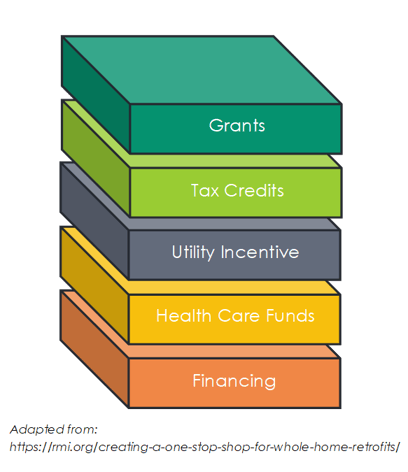Braiding NTG
Over the past few years, in response to the growing climate change crisis, federal, state, and local governments’ funding of energy efficiency and decarbonization projects has increased substantially (to put it mildly). In many cases, both programs and participants are encouraged to combine (or braid) funding from multiple sources to support comprehensive projects. As utility ratepayers are exposed to and take advantage of more sources of funding than ever before for efficiency and decarbonization projects, it brings up a major question: who should get the credit?
Braiding Funding
Retrofitting existing homes (or businesses) to be more energy efficient or decarbonized provides many opportunities to also improve the building’s health and safety, comfort, and energy affordability. However, these deep retrofits can be expensive, and often different funding sources are siloed and only target one aspect of the retrofit without acknowledging other barriers. For example, in many cases, energy efficiency improvements cannot be completed before health and safety requirements are met. This can lead to gaps among certain potential participants. To rectify this, the IRA and BIL promote coordinating different funding sources to maximize uptake and meet a wide variety of needs beyond energy efficiency.
Figure 1. Potential Funding Sources

This makes sense from many perspectives. First, stacking funding allows for a broader and deeper reach of the combined pool than the individual components, making it easier for more people and businesses to decarbonize or otherwise improve their buildings. This is especially important when considering the Justice40 initiative, which specifies that 40% of benefits from incentives from the State Energy Program must flow to disadvantaged communities. Second, coordinating multiple types of services into a single program can reduce total program costs through program efficiencies.
Attribution Issues
Although braiding funding makes sense from a participant and program perspective, utility programs usually can only claim savings that can be attributed to their activities. Determining attribution of braided funding presents both practical and regulatory issues.
First, the practical issue: Most attribution research (i.e., net-to-gross or NTG research) uses surveys or interviews to understand, from the participant’s perspective, the importance of the program on their decision and likelihood that they would have made that decision if the program intervention did not happen. Now, with program participants receiving messages and potentially incentives or tax credits from so many different sources about efficiency and decarbonization, is it realistic for a respondent to be able to parse out if a single source was most important, sufficient and necessary, or required?
The second and more complicated issue is how braiding should be considered from a regulatory perspective. Many jurisdictions have been wrestling with this topic. A good example of this discussion can be seen in California.
Since 2019, the California Public Utility Commission (CPUC) has approved many different decarbonization programs, each with different funding sources, requirements, goals, and evaluation methodologies. It quickly became clear that this could lead to issues, so in 2021, the CPUC released an order that discussed the treatment of incentive layering. Their goal was to decide how to coordinate the diverse programs and incentives to support decarbonization with minimal barriers, as well as how to allocate credit for program benefits.
Stakeholders in California had different ideas, such as applying energy efficiency incentives first to establish an incentive baseline from which other programs may layer additional incentives, attributing success proportionally across overlapping programs by their share contributed to the total incentive, and at allocating attribution proportional to the incremental benefits each program activity contributed (even if not related to energy). There seemed to be general agreement that slicing the pie up too much was not a good idea. CEDMC stated that diluting “the value of an individual program or incentive will result in an increasingly large dead-weight loss to all [overlapping] programs – with the net outcome that all programs will perform worse, deliver less savings, less cost-effectively, and consequently progress on decarbonization and energy efficiency will be slowed.”
Another issue concerning NTG of layered or braided incentives is that the cost-effectiveness testing for demand side management programs is based on net savings (i.e., the savings attributable to the program). However, utilities receive many benefits based on gross savings, such as the avoided costs of transmission and distribution. If, for example, a participant coupled a utility incentive with a federal tax credit and rightfully claimed that the program was only somewhat important in their decision to install efficient equipment, then the cost-effectiveness of the program will suffer while the utility still receives the full benefit of the installation (since the avoided costs of T&D don’t impact the DOE).
Braiding NTG?
In California, the CPUC decided that if a program has a metric that is also targeted by another program (e.g., reporting on kWh savings in programs targeting decarbonization), it should be continued to be tracked, but the existence of another program should be acknowledged in the reporting. This approach promotes transparency around potentially duplicative goals and metrics without disrupting programs. Concerned with the overall cost-effectiveness of overlapping programs, the CPUC said that they may consider a common cost-effectiveness calculation to ensure that the sum of individual program costs does not exceed the sum of the benefits attributable to those programs.
This decision is largely focused on market transformation and may leave many folks focused on resource acquisition programs seeking more precision. But maybe the recent push for large scale decarbonization and the related huge influx of funding can allow for a reconsideration of attribution of programs offered by utilities and other entities. If the goal is market transformation, then we should treat them as market transformation programs. If coordination among different programs and funding sources leads to better outcomes, maybe we should look at their overall contribution to the larger goals rather than seeking to try to measure precise attribution in a way that could slow progress.

